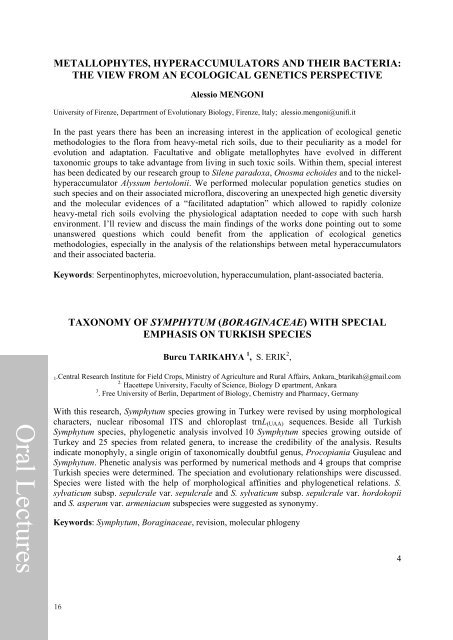Adil GÜNER, Vehbi ESER - optima
Adil GÜNER, Vehbi ESER - optima
Adil GÜNER, Vehbi ESER - optima
You also want an ePaper? Increase the reach of your titles
YUMPU automatically turns print PDFs into web optimized ePapers that Google loves.
Oral Lectures<br />
METALLOPHYTES, HYPERACCUMULATORS AND THEIR BACTERIA:<br />
THE VIEW FROM AN ECOLOGICAL GENETICS PERSPECTIVE<br />
16<br />
Alessio MENGONI<br />
University of Firenze, Departrment of Evolutionary Biology, Firenze, Italy; alessio.mengoni@unifi.it<br />
In the past years there has been an increasing interest in the application of ecological genetic<br />
methodologies to the flora from heavy-metal rich soils, due to their peculiarity as a model for<br />
evolution and adaptation. Facultative and obligate metallophytes have evolved in different<br />
taxonomic groups to take advantage from living in such toxic soils. Within them, special interest<br />
has been dedicated by our research group to Silene paradoxa, Onosma echoides and to the nickelhyperaccumulator<br />
Alyssum bertolonii. We performed molecular population genetics studies on<br />
such species and on their associated microflora, discovering an unexpected high genetic diversity<br />
and the molecular evidences of a “facilitated adaptation” which allowed to rapidly colonize<br />
heavy-metal rich soils evolving the physiological adaptation needed to cope with such harsh<br />
environment. I’ll review and discuss the main findings of the works done pointing out to some<br />
unanswered questions which could benefit from the application of ecological genetics<br />
methodologies, especially in the analysis of the relationships between metal hyperaccumulators<br />
and their associated bacteria.<br />
Keywords: Serpentinophytes, microevolution, hyperaccumulation, plant-associated bacteria.<br />
TAXONOMY OF SYMPHYTUM (BORAGINACEAE) WITH SPECIAL<br />
EMPHASIS ON TURKISH SPECIES<br />
Burcu TARIKAHYA 1 , S. ERIK 2 ,<br />
1.Central Research Institute for Field Crops, Ministry of Agriculture and Rural Affairs, Ankara, btarikah@gmail.com<br />
2. Hacettepe University, Faculty of Science, Biology D epartment, Ankara<br />
3 . Free University of Berlin, Department of Biology, Chemistry and Pharmacy, Germany<br />
With this research, Symphytum species growing in Turkey were revised by using morphological<br />
characters, nuclear ribosomal ITS and chloroplast trnL(UAA) sequences. Beside all Turkish<br />
Symphytum species, phylogenetic analysis involved 10 Symphytum species growing outside of<br />
Turkey and 25 species from related genera, to increase the credibility of the analysis. Results<br />
indicate monophyly, a single origin of taxonomically doubtful genus, Procopiania Gu�uleac and<br />
Symphytum. Phenetic analysis was performed by numerical methods and 4 groups that comprise<br />
Turkish species were determined. The speciation and evolutionary relationships were discussed.<br />
Species were listed with the help of morphological affinities and phylogenetical relations. S.<br />
sylvaticum subsp. sepulcrale var. sepulcrale and S. sylvaticum subsp. sepulcrale var. hordokopii<br />
and S. asperum var. armeniacum subspecies were suggested as synonymy.<br />
Keywords: Symphytum, Boraginaceae, revision, molecular phlogeny<br />
4






